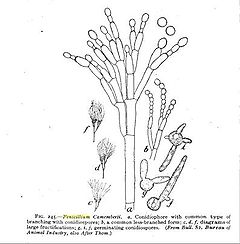Penicillium candidum
| Penicillium camemberti | |
|---|---|
 |
|
| Scientific classification | |
| Kingdom: | Fungi |
| Division: | Ascomycota |
| Class: | Eurotiomycetes |
| Order: | Eurotiales |
| Family: | Trichocomaceae |
| Genus: | Penicillium |
| Species: | P. camemberti |
| Binomial name | |
|
Penicillium camemberti Thom (1906) |
|
| Synonyms | |
|
|
Penicillium camemberti is a species of fungus in the family Trichocomaceae. It is used in the production of Camembert, Brie, Langres, Coulommiers and Cambozola cheeses, on which colonies of P. camemberti form a hard, white crust. It is responsible for giving these cheeses their distinctive taste. An allergy to the antibiotic penicillin does not necessarily imply an allergy to cheeses made using P. camemberti.
When making soft cheese that involves Penicillium camemberti, the mold may be mixed into the ingredients before being placed in the molds, or it may be added to the outside of the cheese after it is removed from the cheese molds.P. camemberti is responsible for the soft, buttery texture of Brie and Camembert, but a too high concentration may lead to an undesirable bitter taste.
Using PCR techniques, cheese manufacturers can control cheese making by monitoring the mycelial growth of P. camemberti. This is particularly significant, as controlling the growth is important to maintain desirable levels of compounds for flavor and to keep toxicity at a safe level.
The fungus was first described by Dr. Charles Thom in 1906. It is considered to be a great subject for experiments and tests as the fungus thrives well in artificial situations, creates dense, enzymatic mycelia, and is readily available in markets from cheeses. P. camemberti is also important economically for the cheese industry.
There are twenty-four isolates of Penicillia, resulting in “considerable taxonomic confusion”. However, these strains are only antigenically related, having similarities in micromorphology, growth rates, toxin production, and the ability to grow in water and at low temperatures. L. Polonelli et al. discovered that the twenty-four isolates can be grouped into nine subdivisions below the species level. This indicates that P. commune Thom is the wild-type, or the strain occurring in nature, ancestor of P. camemberti. The complete genome sequence of P. camemberti was published in 2014.
...
Wikipedia
